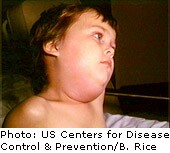
WEDNESDAY, Oct. 31 (HealthDay News) — With intense exposure to the mumps virus, even some vaccinated people may still contract the disease, researchers say.
That’s what health experts believe happened in several Orthodox Jewish communities that experienced an outbreak of the mumps a couple of years ago.
“From June 2009 through June 2010, the U.S. experienced large mumps outbreaks in several large Orthodox Jewish communities, primarily among people who were well vaccinated,” said Albert Barskey, an epidemiologist in the division of viral diseases at the U.S. Centers for Disease Control and Prevention.
Barskey is the lead author of a report detailing the outbreak, published in the Nov. 1 issue of the New England Journal of Medicine.
By 2005, the vaccination rate for mumps was more than 99 percent in the United States, according to the CDC. Although few outbreaks were reported at that time, an outbreak occurred in college-aged students in 2006.
In the 2009-2010 outbreak, the first patient was believed to be an 11-year-old student staying in an area of the United Kingdom experiencing a mumps outbreak at the time. He returned to the United States and attended an Orthodox Jewish camp in Sullivan County, N.Y., also attended by about 400 other boys.
By the time camp ended, 25 people — 22 campers and three adults — had developed mumps. As the campers returned home, mumps spread within the Orthodox Jewish communities in Brooklyn and Rockland County, N.Y. From there, it spread to other Orthodox communities in Ocean County, N.J., and Orange County, N.Y.
About 71 percent of the 3,500-plus cases that eventually occurred were in males, many of them teenagers. The vaccination rates in Orthodox Jewish people were high. Of those infected, 89 percent had received the recommended two doses of the mumps vaccine, while 8 percent had received at least one dose.
Barskey explained that Orthodox Jewish people tend to cluster geographically and socially. Boys spend a great deal of time in religious schools called yeshivas. They may spend up to 15 hours a day in school, he said. And, they study with a partner, working closely together for many hours at a time, face to face, possibly having animated discussions. These partners work at a table with other groups of partners, and they may switch partners during the day. Girls attend conventional schools.
However, Orthodox Jews don’t live in isolation; they routinely interact with people who are not Orthodox Jews, he said. Yet, Orthodox Jewish people accounted for 97 percent of the infections, according to the study. Barskey said this finding strongly suggests that it’s something that happens in the Orthodox Jewish communities that may make them more susceptible, and experts suspect it’s the intense one-on-one contact that occurs in Orthodox Jewish schooling for boys.
“This kind of schooling represents close, prolonged contact where the students can be bombarded with large amounts of the virus. We believe it’s this contact that overwhelmed the vaccine,” Barskey said.
The good news is that those who were vaccinated had a less severe course of the disease than normal. Although mumps in children is generally mild, some kids develop serious problems, including deafness. In rare cases, children die.
Currently, the outbreaks have been contained. But, Barskey said this report shows that “it’s important to maintain high vaccine coverage. The lack of spread outside the Orthodox Jewish community shows that the two-dose schedule in the U.S. is sufficient for mumps control.” He added that there are no additional specific recommendations for the Orthodox Jewish community at this point.
An expert on vaccines noted parallels to other mumps outbreaks.
“These outbreaks are similar to what we saw on college campuses where you have crowding. Vaccines are safe and effective, but the protective effect of a vaccine can be overcome in the right situation,” said Dr. Kenneth Bromberg, chairman of pediatrics and director of the Vaccine Study Center at the Brooklyn Hospital Center in New York City.
The first dose of mumps vaccine is given as part of the measles, mumps and rubella (MMR) vaccine between 12 and 15 months of age, and the second is given between the ages of 4 and 6.
More information
Visit the U.S. Centers for Disease Control and Prevention to learn more about mumps.

